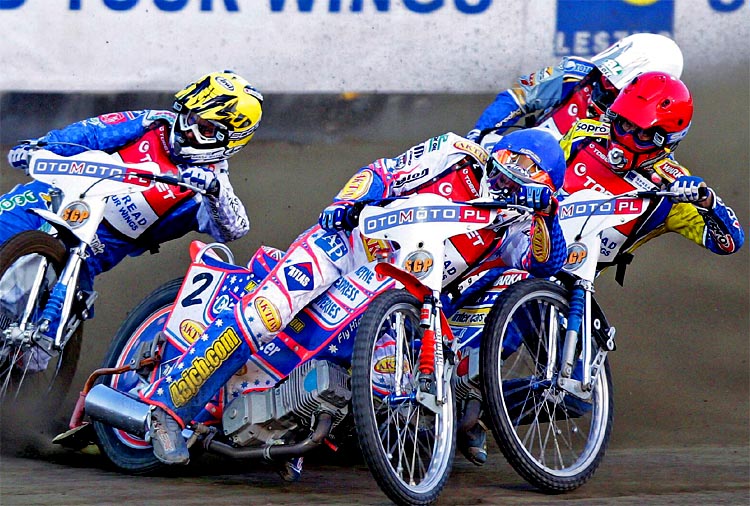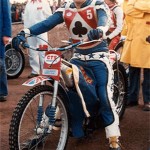Unlike Ice Hockey, I’ve watched Speedway these past 40+ years, more than enough to become weary and cynical about it. Ask almost anyone of a certain vintage with working class roots and they’ll look misty-eyed and say in a distant voice, “Ah, speedway, I used to go when I was a lad, you know. Is it still going?” But before I get to the lows it would be good to start with why the whiff of methanol got in my blood, and the glorious highs it gave me along the way.
For the uninitiated, speedway is conducted on an oval shale track, generally around 300 metres in length. Four motorbikes line up at the starting gate, powerful 500cc engines with no brakes. When the tapes rise, clutches are released and they fire off towards the first bend, slide around the corners then realign for the straights at speeds approaching 100mph peak.
Individual events notwithstanding, league speedway is a head-to-head between two teams of seven riders, graded by a complex calculation from their scores to determine an average, and accorded an appropriate status within the team: heat leader, second string, reserve. Each team puts out two riders per heat, and over the course of 15 races every rider should, barring changes and injuries, face each opponent at least once, culminating in the grand finale heat 15 when both sides nominate their best two riders to fight for the spoils. In practice there is a big home advantage in speedway, though a strong team away to a weaker team will often produce a close finish.
Much of the entertainment value comes from seeing the top riders in direct opposition, though the cliche will often be true, that he who emerges from the gate first will often end up victorious. In the ideal world, overtaking manoeuvres would be commonplace, but sometimes they seem rare as hen’s teeth. which fans usually put down to the slickness of the track – that there is insufficient shale for the bike tyres to grip to overtake. Go on the terraces of your average stadium and you will almost always hear grumbling about the need for “more dirt”.
Nevertheless, the high octane entertainment does still gather crowds in stadiums outside conurbations up and down the UK – colourful, fast and loud bikes, the heady aroma of the methanol fuel used to power them, and riders in bright, colourful kevlars. Not quite like the glory days when speedway proudly boasted that it was the country’s second most popular spectator sport, though. Although the sport famously made its UK debut at High Beech, Epping Forest, on 16 Feb 1928, its two real boom periods came immediately after the second world war, and then in the 1960s. In both times, crowds soared; Wembley stadium supported a club side for many years; tracks flourished up and down the country; young motorcyclists sought fame and fortune in the sport.
For me, the fun started in 1971. My dad took me to matches around then, starting at Coventry and then to what was to be my place of worship for many years: Belle Vue speedway, Hyde Road, Manchester, a big wooden stadium with a huge, wide track, located next to the old Belle Vue funfair (indeed the roller coaster used to overlook the speedway track.)
Belle Vue Aces were then riding the crest of a wave, led by multi-world champion Ivan Mauger until the rider control system of the time reallocated him to Exeter. A youth policy at the time paid dividends, and for several years Belle Vue was a team populated by the brightest young stars of the day, notably my teenage heroes Peter “PC” Collins and Chris “Mort” Morton.
No words of mine can convey the excitement of those heady days. PC, mounted on his new Weslake with 4-valve engine, was poetry in motion. Notorious for being slow from the gate, PC would often be at the back but then be leading by the end of the first lap. Better opponents would be hunted down over 4 laps before engaging in a duel to the line, a cat and mouse game to find openings and exploit them. PC’s favourite ploy was the cut-back, whereby he would go very wide into the 3rd bend, then hook back inside his rival in one fluid movement. Nobody could do that better, and, executed to perfection, it was sheer joy to watch. Collins would bring tears to my eyes on a weekly basis, and Morton, whose style followed very much in the same track, likewise.
My dad would take me all over the country to see matches in those days, and I tried to enthuse as many friends as possible. We followed the Aces almost everywhere. When the old stadium was demolished for a car auction centre, we followed the Aces to the greyhound stadium in Kirmanshulme Lane, though it was never a fraction as good as the old place. Maybe for me that was when speedway began to lose its touch. There were some golden years after that, notably when the Americans Shawn and Kelly Moran, and Bobby Ott, rode for the Aces, but over time the romance has definitely died.
Long after I moved down south, I would still go see the Aces when they were nearby, then sometimes Rye House when I lived near there, but over a number of years my speedway viewing habits have tailed off. Yes, I’ve joined the ranks of the disillusioned supporters who can no longer be bothered to attend.
What killed it for me? Several answers to that, so let’s take them one at a time:
1) Promoters running clubs: These are the people who put their hard-earned readies into buying and running clubs, and frequently lose a packet in the process so some respect is undoubtedly due. That said, and putting it politely, they do make strange decisions, indicative of enthusiastic amateurs from a variety of backgrounds and without any strategic capability or skill dabbling. Leaving on one side financial management and team selection (of which more later), promoters have a tendency to promote badly, to lack marketing and commercial nous, and worst of all, to communicate with fans abysmally. Twas ever thus!
2) Promoters running the sport: not only does the running of individual clubs leave something to be desired, not least because the BSPA (British Speedway Promoters Association, all the owners of all the clubs, run the sport. The lunatics have long since taken over the asylum and make rules which to the outsider make no sense at all; the changes they do make seem to be rearranging deckchairs on the Titanic. To say they have a vested interest is the very least of it; they have no expertise in governance and should not be running clubs as well as taking responsibility for running and development of the sport, let alone decisions from which they as individual promoters can benefit.
When did they ever make long-term strategic decisions for the good of the sport? Well, they doubtless felt like the Sky contract was one, though Sky arguably stitched the BSPA up with a deal that benefits some clubs but not others, the promoter who negotiated the deal pocketed a huge sum, and the sport is totally dependent on the money generated by Sky, most of which either keeps tracks going, or, more likely, goes straight into the hands of riders.
Worse than that: Sky could walk away at any moment. If it did, the entire edifice of Elite League speedway, the division that features at least some of the best riders, would crumble for good.
3) Leisure options & entertainment value: put simply, speedway can’t compete with other options for leisure time with all the options available, many but not all cheaper. However, most league football clubs charge considerably more than speedway, yet are deemed a higher priority for fans, often because of a perceived lack of entertainment value at speedway. For one thing, there is rarely any second half racing, so what you get for your entrance fee is 15 minutes of action. Not enough, particularly if all you get inbetween races is the occasional interview with an inarticulate rider or manager via radio mike!
Speedway has failed to reinvent itself for the 21st century to provide greater entertainment and attract new audiences in the way that cricket did by creating 20/20 – detested by cricket purists, to be sure, but loved even by people who normally would never go near a cricket ground. The base product is simply not going to win over more than the dying hard core of attendees, and let’s face facts: most stadiums are uncomfortable, draughty, have a poor choice of food and drink, and can’t compete with other sports that do take the trouble to think from a spectator’s perspective and provide value for money.
The sport has no clear conception for how to market itself to a new audience that has moved on. There is no clear target audience, nor an understand of how to reach or motivate those segments. Advertising tends to be haphazard and poorly targeted, and nothing has been done to find out why crowd numbers are dwindling and what could be done to reverse the trend. If there has been any serious market research in the past 20 years, it passed me by.
4) Cost/price equation: the sport is traditionally working class entertainment, and most hard core support is from the lower end of the income spectrum, so clubs tend peg entrance to the price point acceptable to most families, but the costs of running a club continue to spiral, notably riders (see below.) Furthermore, speedway is low-key in the media, in spite of Sky TV coverage, and does not attract the high levels of commercial sponsorship gained by many other sports. This gives speedway very little money to invest in new and improved facilities, and barely enough to break even and keep the declining number of league tracks going.
Another thing about costs: speedway bikes are all bespoke and built to order for each rider. They are tuned at huge cost, and each rider will generally turn up to a meeting with 2-3 bikes. Costs could be controlled if engines were standardised and locked so no tuning could be done… but that is a step no speedway authority has ever taken. One alternative would be for clubs to provide standard machinery, ordered in bulk from a few suppliers, and allocated to riders on a random basis – which riders would hate since the frames are customised to their own dimensions, though it would unquestionably save a fortune.
5) Grand Prix circus: the one-off World Final used to be the main event in speedway. Now it’s the Grand Prix circuit, which takes all the leading riders and monopolises one Saturday evening out of two throughout the summer. It hogs the TV coverage, and has been organised as the premier event. However, where Wimbledon and other top tournaments are used to generate revenue to reinvest back in the grass roots of the sport to keep it going and encourage the next generation of young motorcyclists to become speedway professionals. Sure, you hear ideas for this kind of approach, but it never seems to amount to anything serious.
The impact on domestic league racing, the bread and butter of the sport, was never taken into equation. With Saturdays now given over to GPs, very few clubs now run on the biggest leisure day of the week, and attendances suffer as a result.
6) Rider policies: most riders worth their salt ride in at least two, sometimes three, occasionally four European leagues. If they are in the Grand Prix circus, many don’t need to keep another set of bikes and mechanics in the UK, so choose to give our shores a miss, particularly when British tracks are perceived as not paying enough to justify league racing, or if we do choose these riders they charge a mint: bang goes the TV money.
But that’s only the start of the problem. Team equalisation is done by combined averages, which is arguably an ineffective since it does not necessarily make teams more equal at all, but that is another point. In practice, it means mass disruption almost every year, with riders switching between clubs and new imports arrive by the day. The days when riders like PC and Mort were loyal to a club for their entire careers are long gone.
The switches are generally “loans”, though some “full transfers” are paid. However, since almost every rider is on a one-year contract, given the volatility of the transfer market (and the fact that clubs often go out of business or go up or down a division without warning), no club can claim a transfer fee to buy out an existing contract, only for the rider’s licence, which is held by the “parent club”.
Here’s how it works: a rider may be invited to ride from anywhere in the world, and the club pays only to register his licence. Thereafter, they may loan that licence anywhere, or charge a fee for transferring it to another club, but the rider is effectively a piece of meat, nominally an “asset” of a club, even though he may have no contract whatever with that club. Riders switch clubs seemingly at will, or may be dropped without notice if they suffer an injury or have a poor run of form. Contracts mean almost nothing, and if challenged in the courts would almost certainly be breached on a daily basis.
Now here’s the nub: in the ideal world, clubs would have a youth policy, as did Belle Vue in the good old days, and raise their own young talent and put the best on long-term contracts. That way they would encourage trust and loyalty on both sides. For a variety of reasons they rarely run training schools, let alone junior teams, not least because hired stadia do not allow the clubs access outside race days (they frequently share greyhound stadiums.) More to the point, the investment would lose value since riders are often forced out for no fault of their own in order to meet combined average targets, a system which incentivises mediocrity and disincentivises excellence.
Worse than that, young British riders coming up through the ranks of the lower leagues will cost money in transfer fees, where young foreign riders will not. Therefore, the whole system is built to enable teams to hire and fire young foreigners, but never to nurture their own talent. Small wonder that we have not had a British World Champion since 2000, and only two since Peter Collins took the title in 1976, the heyday of my teenage speedway worship. Contrast that with sports like rugby and cricket, where central contracts and national coaching schemes are established with the single desire to make this country the best in the world. Can you blame young lads nowadays for lacking the heroes to make speedway a truly national sport once more?
In short, this has been a sport in crisis for as long as I can remember, and I’m sure it will continue to decline into obscurity until the last of the UK clubs finds it uneconomic to run more than amateur tryouts. It’s sad but not surprising. When Will Carling described the RFU committee as a load of old farts, I wondered how he might describe the BSPA committee – which, by comparison, has presided over years of decline and failure. Small wonder fans debate endlessly but just feel like mushrooms: kept in the dark and covered in shit!!
So how about a positive future? Only if:
- Massive capital can be brought into the sport
- An independent governing body established to set and apply the rules
- A strategy for future growth and youth development established, involving a major reinvention of the sport
- A marketing strategy to win back spectators in large numbers, and for speedway to become once again a market leader.
Somehow, I can’t see this happening, sad to say.








Brilliant article so well written and thought out. I would like to see the averages made easier, like points divided by meetings. Possibly have a north and south leagues and then a play off system. This could possibly cut down on costs. Can’t we also get together with the other boards from Poland , Sweden, Denmark etc and try to come to some sort of agreement for the good of the sport
Hello,
I’m a speedway fan from Poland. I would love to see british speedway live because your tracks are much more attractive for the audience. The ain thing, in my opinion, is that speedway is too expensive nowadays. Why motocross is increasing and speedway dying slowly?
Because long-time fans like me can’t be bothered with league speedway any more and promoters aren’t doing anything to change that. Contrary to what some people think, I also think the televised GPs have been strangling the bread-and-butter sport for years and no money is returning to grass roots to support youth development and facilities. We never learned the lessons!
I adore watching BEL and PL. British leagues are broadcast by our polish sport tv channel. The tracks in UK are technical and difficult, have a more interesting geometry than our polish ones. But the problem is I can’t see the crowd at the stadium. Personally, for me, there are plenty of stupid regulations in british speedway (joker, 30metres behind the tape, guest etc.). I want to see one rider in one club each year, not on Monday he is in X team, and on Friday in Y. Do you think that a new engine from Jawa is a chance for speedway?
Totally agree about the stupid regulations but no idea about engines. All I know is that when I was young speedway was far more exciting.
I have this article in polish. You can translate in google or somehow. Sam Ermolenko was testing this new engine. He is very optimistic.
For example: Obecnie silniki żużlowe kosztują około 6,5 tysiąca euro. Prototyp Jawy wyceniany jest na około 2,5 tysiąca euro.”
engine today = 6,500 eur
new engine = 2,500 eur
They present 2 engine valves, not 4 like today.
New Speedway Foundation.
I can’t send you this website address.
I attend Swindon Speedway on an infrequent basis when time and money allows. I hold dear the tradition of it being a working class sport and feel glad to see men and women at the meetings in work clothes. Speedway must never lose its working class culture and roots. However, apart from a few stadia, most speedway venues are crumbling with little investment in facilities. I would argue that we need to provide corporate sponsorship facilities i.e. lounges, dining, etc where large local businesses (and employers) can bring clients for a great night out. Yes this does mean a big investment in speedway/greyhound stadia, if not the complete demolition of some, but lets encourage local sponsorship from these companies, while also retaining the traditional support and attendance of the working class. This is not a blueprint for social cleansing of speedway or any other sport with appeal to the workers.
Is anyone in a position to recommend good Car Pressure Wash B2B Data List? Thank you 🙂
Thanks for your exciting article. Other thing is that mesothelioma is generally a result of the breathing of materials from asbestos fiber, which is a dangerous material. It truly is commonly observed among workers in the engineering industry with long exposure to asbestos. It is caused by moving into asbestos insulated buildings for years of time, Genetic makeup plays a huge role, and some individuals are more vulnerable to the risk in comparison with others.
Hi there, the whole thing is going sound here and ofcourse every one
is sharing facts, that’s genuinely good, keep up
writing.
By way of introduction, I am Mark Schaefer, and I represent Nutritional Products International. We serve both international and domestic manufacturers who are seeking to gain more distribution within the United States. Your brand recently caught my attention, so I am contacting you today to discuss the possibility of expanding your national distribution reach.We provide expertise in all areas of distribution, and our offerings include the following: Turnkey/One-stop solution, Active accounts with major U.S. distributors and retailers, Our executive team held executive positions with Walmart and Amazon, Our proven sales force has public relations, branding, and marketing all under one roof, We focus on both new and existing product lines, Warehousing and logistics. Our company has a proven history of initiating accounts and placing orders with major distribution outlets. Our history allows us to have intimate and unique relationships with key buyers across the United States, thus giving your brand a fast track to market in a professional manner. Please contact me directly so that we can discuss your brand further. Kind Regards, Mark Schaefer, marks@nutricompany.com, VP of Business Development, Nutritional Products International, 101 Plaza Real S, Ste #224, Boca Raton, FL 33432, Office: 561-544-0719